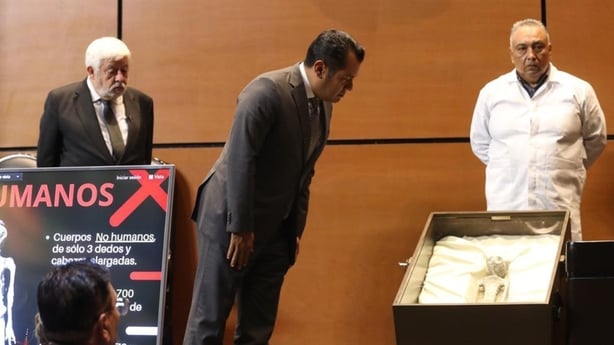The alleged bodies of two "non-human beings" were presented during a congressional hearing in Mexico, generating a mixture of surprise, disbelief and ridicule on social media.
Mexican politicans heard testimony that "we are not alone" in the universe and saw the alleged remains in an extraordinary hearing marking the Latin American country's first congressional event on UFOs.
In the hearing on Tuesday on FANI, the Spanish acronym for what are usually now termed Unidentified Anomalous Phenomena (UAP), politicians were shown two artifacts that Mexican journalist and long-time UFO enthusiast Jaime Maussan claimed were the corpses of extraterrestrials.
The specimens were not related to any life on Earth, Mr Maussan said.
The two tiny "bodies," displayed in cases, have three fingers on each hand and elongated heads.
Mr Maussan said they were recovered in Peru near the ancient Nazca Lines in 2017.
He said that they were about 1,000 years old, analysed through a carbon dating process by Mexico's National Autonomous University (UNAM).
The university's physics institute confirmed in a statement that it had carried out tests but only to determine the age and not the origin of the specimens.
Its laboratory "distances itself from any subsequent use, interpretation or misrepresentation made with the results it issues," a statement said.
Similar such finds in the past have turned out to be the remains of mummified children.
Mr Maussan said it was the first time such evidence had been presented.
"I think there is a clear demonstration that we are dealing with non-human specimens that are not related to any other species in our world and that all possibilities are open for any scientific institution... to investigate it," Mr Maussan said.
"We are not alone," he added.

"They are non-human beings. We don't want to call them extraterrestrials because we don't know," Mr Maussan said during the session called by Sergio Gutierrez, from President Andres Manuel Lopez Obrador's ruling Morena party.
Mr Guiterrez defended the event as being in the "public interest" and during the hearing, asked the speakers to swear to tell the truth.
He said Mr Maussan requested the session after a US congressional committee in July was told by a former intelligence official that humans were not alone in the universe and US authorities were covering up the evidence.
Jose de Jesus Zalce Benitez, Director of the Scientific Institute for Health of the Mexican navy, said X-rays, 3-D reconstruction and DNA analysis had been carried out on the remains.
"I can affirm that these bodies have no relation to human beings," he said.
UNAM today republished a statement first issued in 2017, saying the work by its National Laboratory of Mass Spectrometry with Accelerators (LEMA) was only intended to determine the age of the samples.
"In no case do we make conclusions about the origin of said samples," the statement said.
MPs also heard from former US Navy pilot Ryan Graves, who has participated in US Congressional hearings about his personal experience with UAP and the stigma around reporting such sightings.
Mr Gutierrez said he hoped the hearing would be the first of other similar events in Mexico.
"We are left with reflections, with concerns and with the path to continue talking about this," he said.
In recent years, the US government has done an about-face on public information on UAP after decades of stonewalling and deflecting.
The Pentagon has been actively investigating reported sightings in recent years by military aviators, while an independent NASA panel studying UFOs is the first of its kind by the space agency.
NASA is set to discuss findings from the study today.
An independent team of 16 researchers shared their preliminary observations in May, finding that existing data and eyewitness reports are insufficient to draw firm conclusions, while calling for more systematic collection of high-quality data.
While NASA's probes and rovers scour the solar system for any fossils of ancient microbes, and its astronomers look for signs of intelligent civilizations on distant planets, its historic posture has been to "debunk" sightings on our home planet.
There have been more than 800 "events" collected over 27 years, of which two to five percent are thought to be possibly anomalous, the report's authors said during the May meeting.
These are defined as "anything that is not readily understandable by the operator or the sensor," or "something that is doing something weird," said team member Nadia Drake.
Meanwhile, Mr Maussan faced swift backlash and criticism from sceptics who questioned the authenticity of his presentation.
"This could really hurt efforts to take the issue seriously," said a user of X social media platform. "Why didn't they wait until a scientific paper was ready to publish it?"
Others shared videos of the event with the words "The Martians have arrived," while there was a tongue-in-cheek call for Mr Maussan to be named "president of intergalactic relations."

